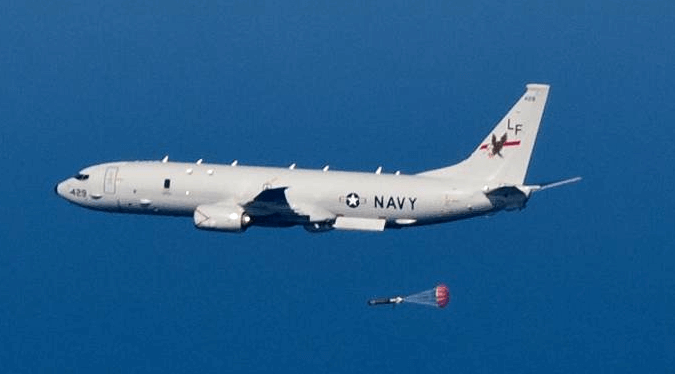In a bid to detect invisible wakes leftover by enemy submarines underwater, the United States Navy is working towards using Advanced Airborne Sensor (AAS) radar on their aircraft.
The AN/APS-154 AAS radar will be installed on US Navy’s Boeing P-8 Poseidon maritime patrol aircraft will offer a change from traditional submarine detection systems by replacing the sonar and magnetic detection.

The Poseidon aircraft will use the radar will help in spotting invisible wakes left by submarines under the surface of the water, after which they can engage the submarines with anti-submarine torpedoes.
According to defense writer Kyle Mizokami writing for Popular Mechanics,
“One such object is the wake created by a submerged submarine on the surface of the ocean. Subs create wakes as they displace water in their path, which is barely visible on the surface. A radar-like AAS can pick out these wakes from the pattern of regular ocean waves, betraying a submarine’s location,”
“Once a submarine is detected, a P-8 can drop an Mk. 54 lightweight anti-submarine torpedo to give chase. The Mk. 54, delivered by parachute, will enter the water, turn on its onboard sonar system, and start searching for the enemy sub. When the torpedo finds the sub, it moves to intercept, detonating a 100-pound warhead against the submarine’s hull.”
Built by Raytheon Technologies Corporation, the AN/APS-154 Advanced Airborne Sensor (AAS) is a multi-function radar mounted in a pod on the P-8 Poseidon aircraft.
Unlike the old rotating-dish radar under a dome, the solid-state ultra-fast electronically-scanned array has no moving parts and moves at the speed of digital.
Aerospace and defense expert, David Hambling explains – “When in use, a hydraulic arm lowers the pod clear of the aircraft’s engines, giving it a clear 360-degree view of the sea below in all directions. The project came out of the highly classified “black” world, and details are still shadowy,”
“We do know, however, that it can operate in a variety of different modes, from scanning broad areas to shooting a tight beam of energy to take a high-resolution radar snapshot from long range or tracking multiple moving objects as small as individuals on foot. It provides monochrome images with photograph-like resolution in all weathers, through clouds and in darkness.”
The AAS radar is the type of active electronically-scanned array (AESA) that has a moving target indicator (MTI) and synthetic aperture functionality.
The function helps the aircraft in tracking moving targets below the sea as well as on the land, with the radar capable of taking high-quality radar imagery of objects even at night or in poor weather.
While Raytheon continues to hold secrecy over the pod and its capabilities, it is clear that the radar has been specifically designed to operate in regions where it might have to scan water and land areas simultaneously.
This is the reason why the AAS radar holds an immense advantage over most traditional surface search radars which are meant to only be used for one environment and not both.
“Radar does not penetrate water, so finding subs from the air is usually a matter of dropping sonar buoys. These have a limited range and even an aircraft as big as the Poseidon – it is essentially a repurposed Boeing 737 airliner — only carries a limited supply. Hence the Navy has long had a great interest in ‘non-acoustic’ methods of finding submarines.” said Hambling.